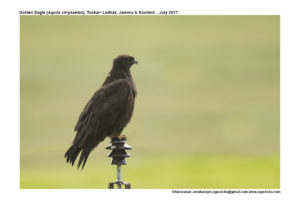Golden-eagle

Golden Eagle Aquila chrysaetos
Etymology:
- Aquila : Latin word aquilus – Dark coloured
- Chrysaetos : Greek Word khrusos- gold ; aetos–eagle { Gold eagle}
Vernacular Names: H.P: Dhungshoorish, Muriari, Pun: Sunehri ukaab
Distribution in India: Resident of Himalayas.
Description: Size of 75-88cm. It is a large eagle with long broad wings with a pronounced curve to trailing edge, long tail and distinctively protruding head and neck.Wings clearly pressed forward and raised with upturned fingers in pronounced V shape when soaring. Adult has a pale panel across upper wing covert, golden crown and nape and two toned tail. Juvenile has a white base to tail and white patch at base of flight feathers.
Habitat: It is found in a variety of open habitats, usually away from humans, e.g. mountains, plateau and steppes; locally marshy areas; prefers low or sparse vegetation to wooded areas. From desert areas to edge of tundra, and from sea-level high into mountains; frequents alpine levels, especially in summer.
Food Habits: Its eats medium-sized mammals, mainly rodents, rabbits and hares; also birds, particularly gamebirds, including large grouse; sometimes lizards and snakes and also carrion, especially in winter. Normally captures prey on ground, using low hunting flight. Sometimes pair members hunt together. When diving (or stooping) in the direction of prey the eagle holds its wings tight and partially closed against its body and the legs up against its tail. In a full stoop, a golden eagle can reach spectacular speeds of up to 240 to 320 kilometers per hour (150 to 200 mph) when diving after prey.
Breeding Habits: They breed in May –June in Upper Himalayas. They build a large nest of sticks and branches lined with greenery. The nest is reused over many decades. They lay a clutch of 2 eggs, laid at interval of 3 days. The incubation period is 41–45 days per egg, almost exclusively by female. The eggs hatch in asynchronous manner and the hatchlings are altricial. The younger chick often dies due to older sibling’s attacks. The fledging period is 65–80 days. Young can be dependent on adults and fed by them for some months, and sometimes tolerated in adults’ home range until following season.